In my continuing posts focused on breast cancer this month, I bring you soy in all its cancer-preventing glory!
I am a stage III, ER positive breast cancer survivor and I eat soy every day. Why? Because I want to reduce my risk of breast cancer recurrence by up to 25% and cure my osteoporosis. Cancer recurrence is a return of cancer after its been successfully treated. In breast cancer, when the cancer comes back, it won’t show up in the breast. It shows up in another body part like brain, bone liver or lung. It’s this metastasis or spread that makes breast cancer lethal. (You can read more in my last post)
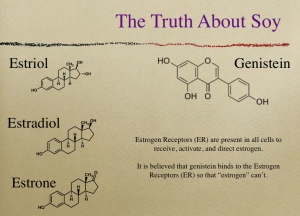 Eating soy…HEALTHY forms of soy…can significantly reduce this risk and also help with strengthening bones and improve your immunity. The magic is in soy’s phytoestrogens (specifically genistein) which are plant chemicals that act as weak binding components to estrogen receptors. No…soy is not the same as estrogen, it just happens to fit the estrogen receptors. (Think of it as a plug cover for an electrical outlet. It fits the outlet, but it’s not powering anything electrical.)
Eating soy…HEALTHY forms of soy…can significantly reduce this risk and also help with strengthening bones and improve your immunity. The magic is in soy’s phytoestrogens (specifically genistein) which are plant chemicals that act as weak binding components to estrogen receptors. No…soy is not the same as estrogen, it just happens to fit the estrogen receptors. (Think of it as a plug cover for an electrical outlet. It fits the outlet, but it’s not powering anything electrical.)
It’s this estrogen-receptor magic that protects women from breast cancer as well as osteoporosis and heart disease. Women who have had a breast cancer diagnosis and eat the proper forms of soy, will be protected from a recurrence. While the exact mechanism is still being studied, the reason may be this: Genistein may be able to weakly bind with the estrogen receptors in your body. There are many forms of estrogen in a woman’s body and they all have different jobs to do. Some have shown that genistein can act as a blocker in the formation of estradiol, the usable potent form of estrogen.
Eating the right kind of soy does not increase ER positive breast cancer cell growth (despite what your doctor might tell you!)
Another theory is that since the genistein is binding with the receptors, that leaves more estrogen free to float around in the blood. The estrogen isn’t really “extra” estrogen, but the sensors that keep track of these things in your body don’t know the difference. They sense an abundance of estrogen, and send a signal to the estrogen making areas in your body that tell the estrogen factories to slow down production. That in turn reduces the amount of estrogen produced and reduces the risk of estrogen sensitive cancers. Soybeans are not the only plants to produce healthy phytochemcials known as isoflavones. They are also found in mung beans, lentils, black beans, and lima beans, but only the soybean has high levels of ER receptor binding genistein. There is also some indication that those who started eating soy at a young age get better protection later in life if soy consumption is continued, so take note if you have daughters.
ER positive AND ER negative breast cancer patients saw a decrease in risk of breast cancer recurrence with soy whether they were taking Tamoxifen or not..
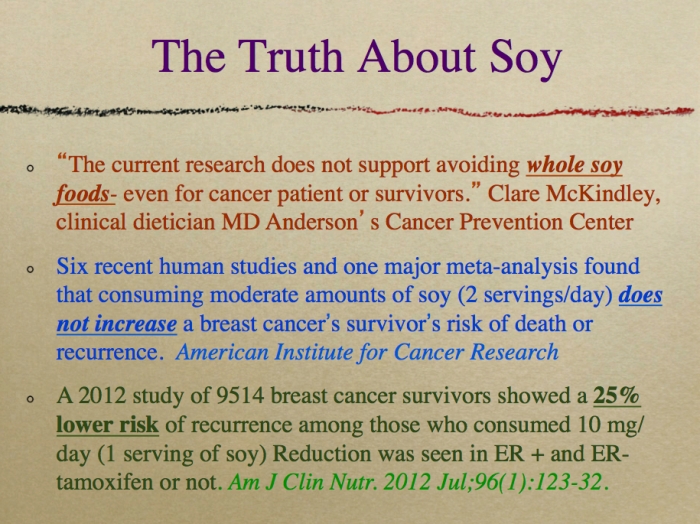
OK, OK I want to eat soy! Where do I start?
There are many different forms of soy and it is IMPERATIVE that you know which are healthy and which are not. The forms of soy are:
- whole soy bean
- fermented soy: miso, tempeh, natto
- processed soy: soy milk, tofu
- Soy “meat-like” products: TVP, veggie burgers, veggie hotdogs, fake bacon, etc.
- Soy protein isolate, hydrolyzed soy protein (MSG): soy powder and soy supplements
Nothing grinds my gears more than misinformation on the cancer benefits of soy!
How do you know if the soy your eating is HEALTHY SOY?
Healthy Whole soy bean: The most nutritious food on the planet, soy is the only legume that contains more protein than carbohydrates and the protein is the perfect form for your body. Unfortunately over 94% of soy that you will come in contact with is GMO (genetically modified) GMO foods can wreak havoc on your immune system by disrupting your gut bacteria. We also don’t know the extent of other autoimmune damage eating GMO foods might do. The way to avoid this? Always eat organic soy products. Organics can never be GMO. Whole soy is also an extremely potent anti-inflammatory making it a great general cancer-fighting food. 1 serving of soy beans would be a nice handful thrown into a salad or soup (about 1/2 cup). Mature soybeans are yellow and have a bit more protein then green soybeans (edamame): 14.3 grams vs 11.1 grams, but both are great choices. But nutritionally, the soy bean is more like a nut and should be treated that way by only eating it in small portions. There are also components to the soy bean that can affect your digestion and mineral absorption called phytates. This component is removed with the fermentation process. So while whole soybeans provide benefits, you should not be eating huge bowls of soybeans every day.
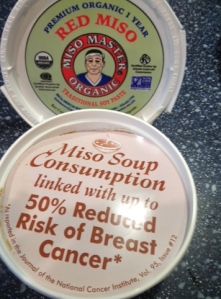 Yes!! Healthiest!!!!!! Fermented soy: Miso, tempeh, natto. When soy is fermented, it’s molecular structure changes. The fermentation process creates a food that still contains the beneficial plant photochemical genistein, but it also possesses fermented food for you gut, which helps to feed your microbiome and increases your immune function. Consuming miso has been linked with a 25% reduction in beast cancer recurrence, a 50% reduction of breast cancer in those without a history, as well as a reduction in other hormone related cancers like prostate. The fermented form of soy called natto (if you can find it) also contains the coveted Vitamin K2 which builds bone after bone loss and helps to increase the availability of vitamin D among other amazing actions. The fermentation process also destroys the phytates present in the whole soy bean that can disrupt digestion.
Yes!! Healthiest!!!!!! Fermented soy: Miso, tempeh, natto. When soy is fermented, it’s molecular structure changes. The fermentation process creates a food that still contains the beneficial plant photochemical genistein, but it also possesses fermented food for you gut, which helps to feed your microbiome and increases your immune function. Consuming miso has been linked with a 25% reduction in beast cancer recurrence, a 50% reduction of breast cancer in those without a history, as well as a reduction in other hormone related cancers like prostate. The fermented form of soy called natto (if you can find it) also contains the coveted Vitamin K2 which builds bone after bone loss and helps to increase the availability of vitamin D among other amazing actions. The fermentation process also destroys the phytates present in the whole soy bean that can disrupt digestion.
OK when used properly Processed soy: Soy milk and tofu are great when used in amounts that are about 1-2 serving a day and are organic (non-GMO). The problem occurs when tofu and soy milk are consumed in large Texas-sized quantities. Americans are taught to drink huge 12-16 ounce glasses of cow’s milk (and you see where that’s gotten us…) and that habit is often carried over to soy milk with consumers thinking that it’s a healthier choice, but it isn’t when consumed in those quantities. Studies done on the isolfalvone genistein for cancer prevention use 10 grams as one serving. 10 grams of isoflavone = 3 ounces of soy milk. If you’re drinking tall 12-16 ounce glasses of the stuff you’re getting way too much. Commercial soy milk also has other ingredients like sugar and carageenan that are not conducive to good health and cancer prevention, so if you can make your own you’ll be ahead of the game. Tofu is the same with regards to serving size. It should be organic and one serving is 1/5 of a block. Huge dishes made with massive cubes of tofu or giant tofu burgers are just not in keeping with the amounts that are deemed healthy when using soy for cancer prevention. Asians in Asia have very low incidences of breast cancer and when you look at traditional Asian food, tofu is used very sparingly…maybe a few thin strips in a soup, and children do not drink milk of any kind..soy or otherwise. Soy milk like whole soy beans, also contains phytates which can affect mineral absorption, so these foods should be used in moderation.
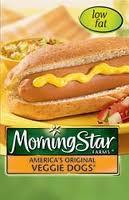
These “veggie dogs” have MILK, EGGS, 4 different forms of MSG, added sugar, artificial colors and flavors and soy protein isolate…healthy?…NOT!
Use sparingly! Soy meat-like products: Soy hot dogs, sausages, burgers, bacon, TVP (textured vegetable protein) and all other products that mimic meat. These products are highly processed and contain isolated versions of soy protein as well as chemical preservatives in some cases. Eating these highly processed soy foods do nothing for your health and they are taking the place of true cancer fighting whole plant-based foods like whole fruits, vegetables, and grains in your diet. Yes, it’s good to reduce your intake of red meats and processed foods like luncheon meats and hot dogs to reduce your risk of cancers, but subbing out highly processed meat-like soy foods on a daily basis is not the best alternative. Once in while, (once a week) should do no harm, but it won’t have the beneficial effect on lowering risk that eating fermented soy foods have. In promoting a cancer-fighting, whole food, plant-based diet, these kinds of fake meat foods really don’t meet either criteria.
Unhealthy! Soy powder and supplements: Included in this list are soy flour and protein powder that contain soy protein isolates and hydrolyzed soy protein. Check any “healthy granola bar” package and you’ll be sure to see soy protein isolate on the ingredient list. Manufacturers think that you believe that a high protein diet is healthy (which it isn’t) so they pack their foods with “fake protein” in the form of extracted soy protein. Not only is this protein GMO, but the extraction process, which involves chemical extractors, removes only the protein and leaves the rest of the healthy components of the soy behind destroying the beneficial effects. Hydrolized soy protein is used as a flavor enhancer and has the same mechanism as MSG (monosodium glutamate) Soy protein powders contain these unhealthy isolates as well. Soy supplements are extremely unhealthy as they contain massive amounts of isolfavones and can have detrimental effects on your health. Too much soy protein isolate has been shown to increase IGF-1 (insulin growth factor-1) in your body. IGF-1 is a potent cancer promoter found in dairy, but also is found in these processed protein rich foods.
The soy protein isolate found in processed foods is NOT THE SAME thing as whole or fermented soy when talking about healthy diets and cancer prevention.
The introduction of soy protein isolate in the vast thousands of manufactured things eaten every day, may be contributing to the rise in hormonal cancers. You are probably consuming a lot more soy protein isolate than you think. It’s everywhere! Take one day and read all your labels looking for “soy protein isolate” in the ingredient list or just look for the allergen alert: soy on the package. Even one of my favorite books Radical Remission makes the mistake of citing a study that shows an increase in prostate cancer with soy, but the soy used in the study was soy protein isolate not fermented or whole soy. No study that looks at the use of whole or fermented soy shows the same results.
Doctors don’t know this stuff!! Please educate them!
Some doctors are telling their patients to stay away from all soy, including soy bean oil, because of the hormonal components. WRONG! The 4-1-1 on soybean oil: Since only the protein contains the phytochemcials and genistein, the oil, which contains no protein and only fat, has no effect.. positive or otherwise… on hormonal cancers. Hormones aside, soybean oil is high in Omega 6 fatty acids and would not be the #1 food choice on a cancer-fighting diet.
For those who have never had breast cancer, the benefits of soy are even more pronounced:
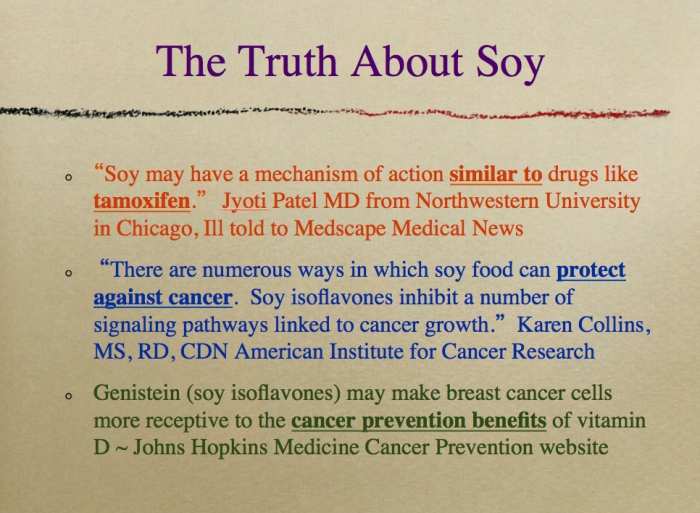
How do I get my soy on? Start using tempeh strips and chunks in salads and stir fry recipes, and make miso part of your favorite foods. I personally only use fermented and whole soy. I eat miso every day one way or another. I use this simple miso recipe as a salad dressings as well as a vegetable sauce and as a dip.
Simple miso dressing:
- 1 tablespoon miso paste
- 1 tablespoon tahini paste
- 1 teaspoon raw honey or alternate non-sugar sweetener like stevia (about 5-8 drops)
- 2-3 tablespoons warm water
Mix miso and tahini together in a small bowl. Add 2 tablespoons warm water and mix very well until it forms a uniform sauce. It will not want to mix right away, but stick with it. Add honey and mix well. Add more water for desired consistency. You may want to make a thinner sauce for salad dressing, but a thicker sauce for sautéed vegetables. Play with the flavors. I’ve added fresh lemon juice, fresh garlic, and other herbs to mix up the flavor. Miso contains sodium, so you don’t need to ever add salt when using it.
I LOVE this on a big kale salad with shredded carrots, pumpkin seeds, dried cherries, chia seeds, and red onion. I also use this on sautéed vegetables. Sauté onions, bok choi, mushrooms, red pepper etc. in a small amount of vegetable broth until soft about 8-10 minutes. Remove from heat. Add sauce and enjoy. Great as a sauce for wraps as well.
Don’t see that fermented soy is healthy an plan to eat it for breakfast lunch and dinner. That’s not the way healthy foods work. The benefits are seen when 1-2 servings/day are consumed. more is NOT better in this case.
If you are a breast cancer survivor, you don’t have to eat soy, but please don’t fear the soy! If you choose to, embrace it as another tool in your cancer-fighting toolbox and start building a healthy cancer-free life!
Please be careful when googling info about soy. Newer and larger studies looking at genistein and breast cancer have only been around for 2 years. Check the dates of your studies. Also, those in the dairy industry, in particular, are losing a lot of money to soy milk buyers and will go to great lengths to discredit and spread false info about soy. Their advertising even targets and tried to discredit soy milk buyers. Always consider your info source.
Categories: breast cancer, breast cancer awareness, cancer prevention, healthy living, women's health
Hello Susan. Thanks for this very informative post. I was surprised at the headline – that doctors would ask patients to avoid soy, but then in our environment we do not encounter GMOs or meat-like soy products. So I guess, there is indeed a caveat to the use of soy products, but this has to be properly qualified. And yes, the doctors need more education on this. Cheers!
Hi Victor! Yes, when you hear “soy” you shouldn’t make any decision about whether it’s good or not until you hear what KIND of soy it is. To say that all soy is bad is not true. Thanks for your comment! ❤
Hi Susan I just discovered your blog and I am a breast cancer survivor who was told never to eat anything soy because I was estrogen positive and do so I would make it worse. Now I am in pre-menopause and am suffering so badly because there’s nothing I can do or take; do you have any suggestions on a supplement that would really help my symptoms? I did find one but it had soy isoflavones In it…..So now I’m scared to take it. So confused on what to do. Thanks Michelle
Hi Susan, I just discovered your blog thanks to your comment on The Muffin Myth. This is such an informative article. Thank you! As vegans, my daughter and I have been so nervous about soy consumption. I already knew to stay away from soy isolates, but the information that continues to flood the airwaves made me afraid to eat soy or miso as well, even though my Ob/gyn told me that it was safe to eat in moderation. I just bough some red miso last week, you can be sure that I’ll be having some for lunch today. Thank you!
Thanks so much for your comment! I eat red miso too! If you want, you can try this easy sauce/salad dressing (which I eat pretty much every day LOL) and please share your own recipes! Id’ love to hear how you use your miso.
I discovered your site after seeing it mentioned on OneGreenPlanet.org. I LOVED this article and just read it to my husband as we are committing to a plant-based diet for our family. I also forwarded the article to women in my family and have subscribed to your site! Many thanks. 🙂
Bravo to you to making the healthy happy change to a more plant-based life!!!!!You have no idea how happy your comment makes me! My mission is to spread the word about how you can take control over what you eat, think, and do to live happier! Please take a look at my new web site http://www.CancerSurvivorsForLife.com. There you’ll find a 28-day nutrition course. It says it’s for cancer prevention, but it’s really to avoid ANY chronic illness and eat plant-based. Thanks again so much! ❤ ❤
I just read this again, Susan. Thanks for the reminder! I find it very difficult to get tempeh or miso around here, but I will check out the health stores in St. John’s the next time I go in!
Thanks for the comment! If you can’t it’s not a problem, I am more thinking of the people who stopped eating soy because of their breast cancer diagnosis not knowing that they were doing good! (PS…I know they serve it at Sprouts!)xxoo
I hadn’t realized that miso is fermented soy. Hmm, good to know!
Yes! The fermentation process is very healthy. Have you ever tried kombucha?
There are some soy free miso’s made from chick peas, but usually it’s made from soy.
I have used your miso dressing and love it — I am constantly finding new ways to use it. Could you tell me the difference, if any, between red miso and the other ‘colour’ misos? Does one colour do more than another?
Thanks for your comment!! I use it almost every day too! Tell me some ways you’ve used it! The different colors have to do with the grain that it is fermented with whether it’s rice, or barley etc… Red is the strongest flavor because it is fermented longer…sometimes 20 years!! That is what I like. The lighter colors can be milder. But they are all healthy fermented soy!
Thanks! I have been making “Buddha Bowls” with whatever I find at my local organic farmstand. Recently it’s shitake mushrooms, eggplant, red pepper, onions and summer squash over organic brown rice, dressed with your miso dressing. The dressing makes it all taste great!
Excellent!! We’ll have to do the farmers market thing when you come visit!
This is so good to know! My oncologist has told me to avoid soy, and as a non-meat eater, I love tofu (and thanks for the reminder to use organic and to eat it in small quantities!). I’m going to try your miso dressing. Yum!
Thanks for the read and comment! No need to avoid tofu. Your doctor is up to date on the latest drugs because there are reps that go in and bring them lunches and get them to prescribe their drugs, but ask a doctor about foods, and don’t know much. They are mostly just doing what the other doctors are doing 🙂 I wish I could be a “food rep”! 🙂
Wonderful article and very informative! NIce miso dressing too, I’ve only done miso dressing in lemon juice/ vinegar base.
Thanks! yes! Miso is great with lemon! Thanks for the comment!
Soy scares me. After I had my cancer in 1996, the following spring I started eating about 25 mg of isoflavens a day, mainly in the form of a cereal. Two weeks later I began to have bright red vaginal bleeding four days after my period was done. I had a biopsy done and it showed endometrial hyperplasia. TIME magazine, ironically, that same week came out with an article about the same thing, linking soy to endometrial hyperplasia. Within 12 hours after stopping the soy the bleeding stopped. Those phytoestrogens apparently were too much for me.
So sorry for that! Your story is interesting because soy doesn’t work that way in your system. Endometrial hyperplasia take weeks/months/ sometimes years to develop. I’m glad your OK now! Thank for commenting!
Fantastic article and very interesting. Many people in the UK are swayed by the negative soya rumours and its wonderful to read something that dispels these misconceptions. Soya is a hugely nutritious food and the fact that all those cancer stories are bogus makes me elated. Bring on the tofu! I will spread the good message liberally. Peace, lee
Thanks so mcuh for your taking the time to read an respond. It’s a shame that the industries that are threatened by consumers using soy are allowed to spread false information. Appreciate the comment!
Informative, as always. I like to use miso in my “famous” mushroom gravy!
Thanks Flo! Please post the link!